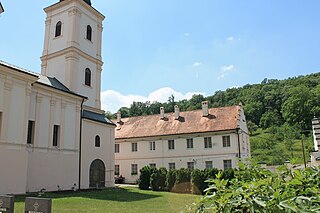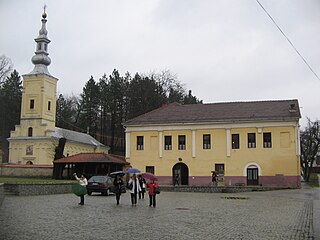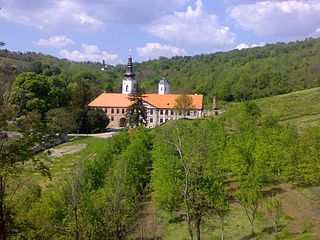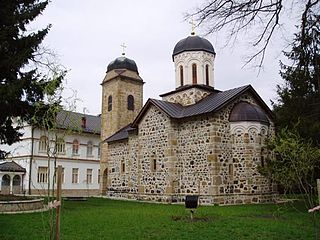 W
WThe Beočin monastery is a Serbian Orthodox monastery, located just outside Beočin, on Fruška Gora mountain in the northern Serbian province of Vojvodina.
 W
WThe Bešenovo Monastery was a Serb Orthodox monastery on the Fruška Gora mountain in the northern Serbian province of Vojvodina. It was located by the Čikoš stream, in the area of the Bešenovački Prnjavor village. During World War II, the monastery was destroyed in the bombing. At the moment it is being rebuilt.
 W
WBogovađa Monastery is a Serbian Orthodox monastery located in Bogovađa near Lajkovac in central Serbia. The monastery has been a bastion of learning since its inception. It had been renovated several times in history, the original monastery dating back to the 15th century, founded by Serbian Despot Stefan Lazarević. Hieromonk Mardarije erected a new monastery, dedicated to St. George, at the location of the ruins, in 1545. It was destroyed in the 18th century, then reconstructed by clergymen Hadži-Ruvim, Vasilije Petrović and Hadži-Ðera between 1791 and 1795. It was renovated in 1806 by Avakum, and Prince Miloš Obrenović in 1816. The present church facade dates to 1852, while the iconostasis was finished by 1858 by Milija Marković and his sons from Požarevac. Hieromonk Mardarije and prince Grgur Branković were buried in the monastery. The churchyard includes tombs of soldiers over two centuries, and a fountain built in 1796. The locals called the fountain Bogova voda, hence the name of the monastery.
 W
WThe Church of St. Nicholas is a Serbian Orthodox church built in the mid-16th century, located in Gotovuša, Kosovo. It lies by the village graveyard.
 W
WThe Church of the Holy Archangels Michael and Gabriel, also known as the Old Orthodox Church, is a Serbian Orthodox church in Sarajevo, Bosnia and Herzegovina. It was first mentioned in Ottoman sources dating to 1539. The Church was, however, built on older foundations).
 W
WThe Divša Monastery, also known as Đipša (Ђипша), is a Serb Orthodox monastery on the Fruška Gora mountain in the northern Serbian province of Vojvodina. It is believed to have been founded by Despot Jovan Branković in the late 15th century. The earliest historical records about the monastery date to the second half of the 16th century. Owing to Turkish raids, the monastery was deserted in the 17th century; at the beginning of the 18th century, Dipša was mentioned as an appendage of the neighbouring Kuveždin monastery. Its old church underwent reconstruction in 1744, but the final alteration was made in 1762, when a new narthex was built. A chapel dedicated to the Mother of God was placed therein, upstairs. The iconostasis for the restored church was carried out by Teodor Stefanov Gologlavac in 1753.
 W
WDovolja is a Serbian Orthodox monastery located on the right river banks of the Tara, near Pljevlja, in the village of Premćani within the hamlet of Dovolja. It is dedicated to the Assumption of the Holy Mother of God. It is believed to have been founded by King Stefan Milutin at the end of the 13th century. It was first mentioned in 1513. It is ecclesiastically administrated by the Eparchy of Mileševa. Some time after 1699, the relics of Archbishop Arsenije I were moved from Dovolja to the Dobrilovina Monastery.
 W
WThe Gomionica Monastery is a Serbian Orthodox monastery dedicated to the Presentation of Mary and located at the village of Kmećani, 42 kilometres west of Banja Luka, in the Republika Srpska entity of Bosnia and Herzegovina. The monastery is the spiritual centre of the region known as Zmijanje.
 W
WThe Kuveždin monastery is a Serb Orthodox monastery on the Fruška Gora mountain in the northern Serbian province of Vojvodina. Traditionally, its foundation is ascribed to Stefan Štiljanović. The first reliable record of its existence is from a Turkish tax book dated from 1566 to 1569, though the building was constructed much earlier. In 2009, the entire monastery complex has been reconstructed.
 W
WThe Lomnica Monastery is a Serbian Orthodox monastery dedicated to Saint George and located near Šekovići in the region of Donji Birač in the eastern Republika Srpska, Bosnia and Herzegovina. The monastery's church and dormitory are built on a narrow flat area on a hillside beside a stream called Lomnica, from which the monastery received its name. In the local accent, the consonant pair mn is often pronounced as vn, hence the form "Lovnica". As lov means "hunt" in Serbian, this gave rise to legendary accounts of the monastery's foundation that connect it in some way with hunting or hunters. According to one of the legends, the area of Lomnica was a hunting ground of the Serbian King Dragutin Nemanjić, and it was he who built this monastery. The region of Donji Birač contains many medieval necropoleis with the characteristic stećak tombstones and other archaeological artifacts.
 W
WThe Orahovica Monastery is a Serbian Orthodox monastery in Orahovica, Croatia. It is mentioned in 1583 when it was a seat of the Požega metropolitanate and an important culturo-religious center, located in the then Virovitica County. It is thought to have been built before the end of the 15th century.
 W
WThe Ozren Monastery is a Serbian Orthodox monastery dedicated to Saint Nicholas and located 6 kilometres from the town of Petrovo in northern Republika Srpska, Bosnia and Herzegovina. It is the spiritual centre of the area of Mount Ozren. It was probably founded in the second half of the 16th century, during the office of Serbian Patriarch Makarije Sokolović, who was granted permission from the sultan of the Ottoman Empire to renovate and build churches and monasteries. Folk tradition, formed in the 18th century, has it that the Ozren Monastery was founded by King Dragutin, a member of the Serbian Nemanjić dynasty, who ruled north-eastern Bosnia from 1284 to 1316.
 W
WThe Papraća Monastery is a Serbian Orthodox monastery dedicated to the Annunciation and located in the village of Papraća at the source of the same-named river, near Šekovići in eastern Republika Srpska, Bosnia and Herzegovina. The date of its foundation is unknown, but contemporary Ottoman documents give evidence that the monastery existed in the first half of the 16th century.
 W
WThe Petkovica Monastery is a Serbian Orthodox monastery located on Mount Fruška Gora, in the province of Vojvodina, northern Serbia. According to tradition, it was founded by the widow of Stefan Štiljanović, Despotess Jelena. The earliest historical records mentioning the monastery are dated to 1522.
 W
WRajinovac is a Serbian Orthodox monastery located in the south end of Begaljica. While its date of founding is not known, it was first mentioned in the year 1528 in the Ottoman census of the Belgrade municipalities, listed as "Monastery of saint Rajko" - Manastir Svetog Rajka. The first major renovation of the monastery and church was completed by Knez of Begaljica Stevan Andrejević- Knez Palalija in the year 1793. The church is dedicated to the Nativity of the Mother of God.
 W
WThe Rmanj Monastery is a Serbian Orthodox monastery dedicated to Saint Nicholas and located in Martin Brod in north-western Bosnia and Herzegovina, at the left bank of the Unac River near its confluence with the Una.
 W
WŽitomislić is а Serbian Orthodox monastery dedicated to the Annunciation and located near Mostar, Bosnia and Herzegovina.